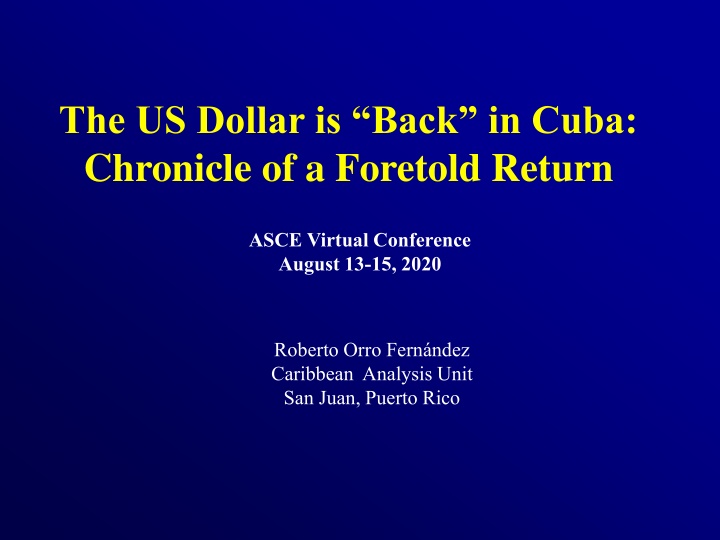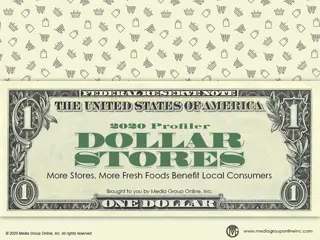The Resurgence of the US Dollar in Cuba: Implications and Challenges
The return of the US dollar to Cuba after 15 years has significant implications on the economy and the Cuban Peso. This resurgence, exacerbated by the COVID-19 crisis, has highlighted the weaknesses of the Cuban monetary system and the challenges it faces in unifying its currency. The distrust in local currency, the CUP, and the limitations of the CUC as a store of value have pushed the US dollar to the forefront. The Cuban government's handling of the crisis, coupled with increased demand for dollars, has put immense pressure on the local currency, creating a complex financial landscape in Cuba.
Download Presentation

Please find below an Image/Link to download the presentation.
The content on the website is provided AS IS for your information and personal use only. It may not be sold, licensed, or shared on other websites without obtaining consent from the author.If you encounter any issues during the download, it is possible that the publisher has removed the file from their server.
You are allowed to download the files provided on this website for personal or commercial use, subject to the condition that they are used lawfully. All files are the property of their respective owners.
The content on the website is provided AS IS for your information and personal use only. It may not be sold, licensed, or shared on other websites without obtaining consent from the author.
E N D
Presentation Transcript
The US Dollar is Back in Cuba: Chronicle of a Foretold Return ASCE Virtual Conference August 13-15, 2020 Roberto Orro Fern ndez Caribbean Analysis Unit San Juan, Puerto Rico
Order of Presentation Introduction The Return of the Dollar in 2019 Fallacies and wrong assumptions on dollarization and monetary unification in Cuba The greenback is back in full force in 2020 What is next?: Time is running out for the Cuban Peso
The Return of the US dollar After hiding backstage for 15-years, the US dollar has come back stronger than ever. In 2019, the Government designated some stores for dollar transactions. In 2020, in during Covid-19 pandemic, the greenback is back in full force in 2020. The CUC is still used for local transactions but is no longer useful as store of value.
The CUP is on Life Support Demand for US dollars has exploded. The Cuban people distrust the CUP and the CUC. Cuban leaders only trust the US dollar. Although the Cuban government has handled Covid- 19 crisis relatively well, the virus is taking a heavy toll on tourism, remittances and the economy in general. A perfect storm for the Cuban Peso (CUP): stronger demand with a limited supply of US dollars.
The CUC has lost strenght $ US dollar/one CUC
What the Unification Discourse Really Meant Though COVID crisis expedited process, pandemic is not the cause of the dollar s return. Government never meant a true monetary unification: the Zero Day was a ruse to take more CUCs out of circulation. A road map for unification never carefully laid out. The government s critique of the dual system was in effect a complaint about the weakness of the CUC
Fallacies and Wrong Assumptions on the Cuban Dollarization
Monetary Dualism or Monetary Troika? Cuban monetary system is a troika rather than a dual system. Top: US dollar Middle: CUC as buffer and taxation tool, and as way to prevent compromising government s US dollar reserves; Bottom: CUP. CUC has worn out. Has lost its taxation power and has a disruptive effect on the supply chains of the economy.
Monetary Dualism Introduced Economic Distortions If it were true, we would have to conclude that Cuba had a more efficient monetary system in the 80s, during the cusp of the central planning and the honey moon with the Soviet Union. The artificial rate of one to one was not an invention in the early 90 s; it has existed for five decades The exchange rate labyrinth was complicated by the system of bartering with Council for Mutual Economic Assistance (COMECON) member countries.
Dollarization Started in the Early 90s and Ended in 2004 Since 1960, Cuba has lacked a convertible currency. Monetary dualism did not start in 1993. That year Cuban citizens were simply allowed to hold/ use US dollars. Cuba had its own berioskas before 1993. In 2004, the government withdrew US dollar from circulation as a way to protect national dollar reserves. Monetary dualism is just the mirror of economic duality, an inherent feature of most centralized economies.
Monetary Dualism Hampers Exports Led to Crash of Sugar Industry Importers do not enjoy a preferential rate, nor do they have free access to hard currencies. Most imported goods end up in the dollarized network (TRD, CIMEX, ETECSA). Had the government opened the sugar industry and the agro sector to foreign investment as it did with tourism, nickel and, more recently, ports, the sugar industry would have retained its competitive edge.
Monetary Dualism Exaerbated Inegalitarian Society Cuba has never been a truly egalitarian society free of social disparities, even from 1959 to 1993. Top officials enjoyed privileges and economic conditions unthinkable for the Cuban people. The legalization of the US dollar in 1993 cut the traditional link between economic prosperity and political loyalty. Now, social differences are more visible than before, but this is not the same as saying that Cubans were better during the 80 s.
What is Next? Time is Running Out for the Cuban Peso
Dollarization and the Economic Power of the Cuban Army Although the Cuban Armed Forces remain a public institution, its commercial arm resembles large Latin American holding companies [GAE = TRD, Gaviota, Cimex...] Armed Forces and their foreign investment partners share aversion for CUP and affection for US dollars. They will never embark in a monetary adventure with the CUP: If it is not broken, don t fix it.
The Inconvenience of Monetary Unification The government/army and their powerful holding companies will never take exchange risks. A number of options are unfeasible: Coming back to the economic apartheid of the 80s and 90s is irrational, since more and more ordinary citizens have access to US dollars and other hard currencies. The wide use of the CUP will lead to a worse mess of preferential exchange rates, privileges to purchase US dollars and differentiation between foreign investors, among other problems.
Discouraging News from Overseas Since 2018, emerging market currencies have suffered great pain. Investors are obsessed with US bonds and FAANG stocks. During the Covid crisis, the FED provided some relief via swaps to Latin American central banks Are Mexico, Argentina and Brazil doing better than Panam , El Salvador and Ecuador in economic terms?
Monetary Unification? Monetary unification in CUPs is just a dream. Cuba missed a great opportunity to advance the unification goal during 2008-2012, when petrodollars were flowing from Venezuela. Quite the contrary, dollarization has spread to Venezuela. Now, in the midst of a very adverse economic situation, local as well as external, Cuba lacks the backstop needed to overhaul the CUP.
Monetary Unification? The Cuban leadership and the political system in general stands against the CUP. Cuban leaders have strong addiction to US dollars and strong aversion to CUPs. Raul Castro succession plans keep moving on. People are getting used to a new leadership. Whatever the outcome in the next US election and in spite of potential unrest in Cuba, the Communist Party, their leaders and the system in general with retain its grip on the Cuban society: nobody in the US wants a political earthquake in Cuba.
Monetary Unification? Winners and Losers Who wins, who loses? It depends on the benchmark. The Cuban government is the biggest winner, it is hedged : faces no exchange rate risk. Cuban workers whose salaries are paid in CUCs and have no access to US dollars are the biggest losers. However, cuentapropistas and many Cubans with access to US dollars also gain with dollar comeback.
Questions that Must be Answered Who or what is going to force the Cuban leadership to end its sixty-year dependence on the US dollar? Let s assume that the CUP is restored as the only currency. How will Cuban leaders react if they lose money due to exchange rate movements? Who is going to provide the financial backstop to create and develop an independent monetary authority?. What about transition costs, a competent staff and other related issues? Millions of Cubans and foreigners with stakes in Cuba are used to operating in foreign currency without facing exchange risks. Who or what can change that?
Conclussions The Cuban government has no real incentives to embark on a risky and complicated monetary unification. The CUP is at its low ebb. A transition scenario with CUP restored as true national currency in hard to imagine.























